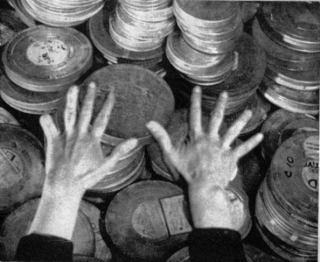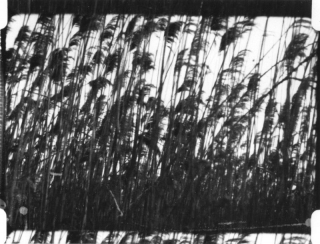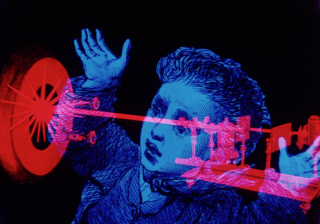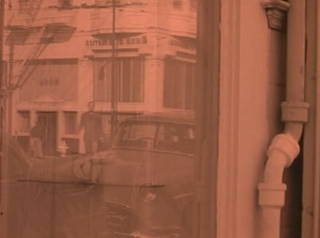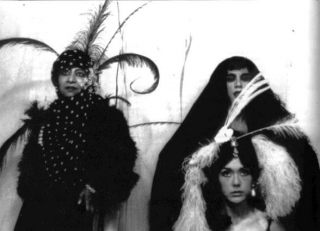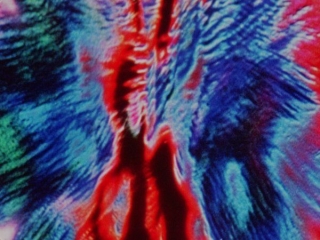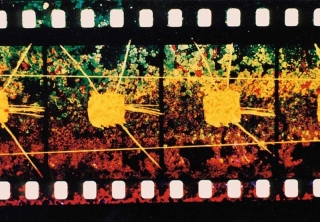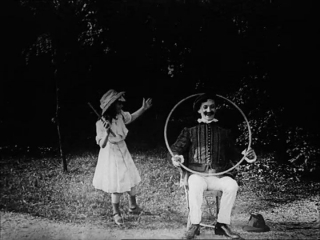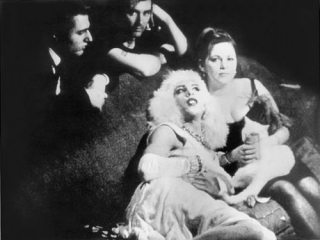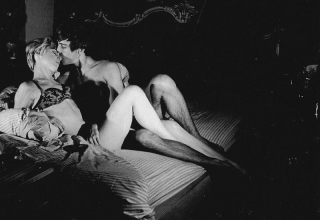Genius and Junkie: Burroughs in Britain
Date: 14 March 2001 | Season: Burroughs in Britain, Miscellaneous
GENIUS AND JUNKIE: BURROUGHS IN BRITAIN
Wednesday 14 March 2001, at 6:30pm
London Tate Britain Clore Auditorium
Cult author Iain Sinclair, film curator Mark Webber and Tim Marlow (BBC broadcaster and editor of tate: the art magazine) come together to revel in and debate the impact of the great American Beat novelist William Burroughs on the underground arts scene in London.
Focusing on the 1960s and 1970s, when Burroughs lived for a number of years in the city, this exciting event will include screenings of two films Burroughs made in collaboration with the British film-maker Antony Balch, The Cut-Ups (1963) and Towers Open Fire (1967).
Antony Balch, Towers Open Fire, 1963, 16mm, b/w, sound, 10 min
Antony Balch, The Cut-Ups, 1967, 16mm, b/w, sound, 19 min
Lock them out and block the door
Bar them out for evermore
Lock is mine and door is mine
Three times three to make up nine
Curse go back curse go back
Back with double pain and lack
Change the lock and change the door
Smear them out for evermore
Curse go back curse go back
Back with double fear and flack
Silver arrow through the night
Silver arrow take thy flight
Silver arrow seek and find
Cursing hearts and cursing minds
WHO WAS ANTONY BALCH ?
(some things about his film collaborations with William Burroughs & other tenuous connections leading further out)
I discovered the film collaborations of William Burroughs and Antony Balch as a teenager. They were an inevitable step for an inquisitive youth learning about the underground sub-culture. Back then, they were intriguing for their weirdness, but looking again at the films now, with my current understanding of the avant-garde, I am amazed by the formal innovation contained in the films. So many demonstrations of the power of cinema are harnessed in the brief 10 minutes of Towers Open Fire. Different sections echo developments in many areas of film practise. It’s hard to know how much of it was achieved consciously, since it is known that Balch and Burroughs had some limited exposure to experimental film. I have the impression that their collaborations existed almost in a vacuum, that the creativity was spontaneous and original, arising from the hotbed of invention they were working in. The ideas in the films have been so often imitated and diluted that people have forgotten the dynamism of their origin. Once produced, the films continued to exist outside of the recognised canon of experimental film, and aside from several screenings organised by the London Film-Makers’ Co-operative, were rarely seen alongside those of their peers. Balch’s grounding in more conventional cinematic business may be a reason for this, leading to the films being most often screened supporting feature films in first run or repertory theatres. We can only imagine the havoc they might reap on unsuspecting, upright members of a less sophisticated audience. It is a testimony to the strength of vision that even within the most avant-garde circles, The Cut-Ups still manages to provoke strong reactions.
The Cut-Up
Brion Gysin devised the cut-up process in the “Beat Hotel” at 9, rue Git-le-Coeur in September 1959. It was discovered by accident when he noticed the shredded columns of newsprint that he’d been using as support while he cut a mount for a drawing. Its main precedent in literary history was a piece by Tristan Tzara, a Romanian-born French author and leading Dada activist. He provoked a riot in the 1920s when he proposed to create a poem by pulling words at random out of a hat, prompting Andre Breton to expel him from the Surrealist group. Early examples of the application of the cut-up technique can be found in books by Gysin, Burroughs, Gregory Corso and Sinclair Beiles (a South African Jewish Poet of questionable mental stability, whose books include “Universal Truths as Revealed in White Tobacco Fumes”, “Sacred Fix” and the Olympia Press erotic novel “Houses of Joy” (using the exotic nom de plume of Wu Wu Meng)). These four authors collaborated on “Minutes To Go” (Two Cities Editions, 1960) and Burroughs and Gysin worked together again on “The Exterminator” (Auerhahn Press, 1960).
In his own work, Burroughs’ application of the cut-up was less literal and more literary, using it to formulate ideas that were then reworked and more consciously structured. His most evident use of the technique is in the three books “The Soft Machine” (Olympia Press, 1961), “The Ticket That Exploded” (Olympia Press, 1962) and “Nova Express” (Grove Press, 1964).
Tape Experimentation
During this time their colleague Ian Sommerville, an English mathematician, realised early tape compositions by similar means. Gysin and Sommerville’s early tape experiments received a public airing in England in 1960. “The Permutated Poems of Brion Gysin” (as put through a computer by Ian Sommerville), produced by Douglas Cleverdon at the Radiophonic Workshop and broadcast by the BBC. Combining layers and repeats of acoustically similar sounds, compositions like “Pistol Poem” bear similarities to the experiments done in the USA at the San Francisco Tape Music Centre, which was founded by Ramon Sender, Morton Subotnick and Terry Riley in 1959.
Tape music was first developed in post-war France by Pierre Schaeffer and Pierre Henry on “Symphonie Pour Un Homme Seul” in 1950. The Columbia University tape studios were established a year later by Vladimir Ussachevsky and Otto Luening. These early laboratories laid the foundations for Musique Concrete, a new compositional form, which combined musical instruments with field recordings, electronically produced effects, and speech. The recordings by Gysin and Sommerville take a slightly different approach, being almost non- or anti- musical, impulsive and home made, more in-line with work of this period by John Cage and Richard Maxfield (who is known to have assembled audio at random, pulling cut-up sections of tape out of a bowl). Their influence on the new music pioneers is unclear, though from descriptions, the “Permeated Poems” and other early concrete or sound poetry appear closely related to later, better-known linguistic process music of Steve Reich (“It’s Gonna Rain, 1965, which developed out of a tape composition he’d made for Robert Nelson’s film Plastic Haircut in 1963) and Alvin Lucier (“I Am Sitting In A Room”, 1971). There are also parallels with the Concrete Poetry movement. In 1960, Gysin had founded the Domaine Poetique group with Henri Chopin, Françoise Dufrêne and Bernard Heidsieck. Taking sound poetry further into performance, the collective presented live events at the London ICA and Paris American Centre, combining sound with optic and perceptual experimentation such as projection of bodies onto bodies to transmit unsettling double visions.
Burroughs himself went on to investigate the magical properties of audiotape in the electronic “spells” he cast in the 60s and 70s. By playing recorded sound back to its source or at it’s original location he sought to create a kind of subliminal feedback loop. Its harmless analogy in music could be composer Max Neuhaus, who investigated environmental sound in pieces like “Public Supply” (1966), a work in which the sounds submitted by listeners over the telephone were instantly altered, combined and played back to them over the radio. Burroughs application of the technique was less benign; one story tells of Parisian newspaper kiosk that burnt down (with its malevolent owner inside) in ’61 or ’62 after one of his hostile street playbacks.
Antony Balch
Antony Balch was an Englishman who had been working in the film industry in London and Paris from an early age. Much of his childhood was spent at the movies, where his hero was Bela Lugosi. In the late 1950s, Balch made early television commercials, before working on English subtitles for foreign features distributed by Mondial Films, including films by Antonioni, Louis Malle and others. His first assignment was a British trailer for Fellini’s Nights of Cabiria (1957), and from there he progressed to being responsible for subtitling on Last Year at Marienbad (Alain Resnais, 1961), Dreams (Ingmar Bergman, 1955) and The Trial of Joan of Arc (Robert Bresson, 1962).
In 1959, Balch had begun a personal film project featuring his friend Jean-Claude de Feugas. After shooting around Paris with his wartime De Vry 35mmm camera, Balch realised it was “terribly pretentious” and abandoned the film. De Feugas lived at 10 rue Git-le-Coeur, and at a party in his apartment he introduced Balch to his neighbour Brion Gysin. Gysin subsequently introduced Burroughs to Balch, who became intrigued with the unusually creative group. Balch recognised the cinematic potential of the cut-up, and soon started to adapt and apply this technique in a series of film collaborations.
Towers Open Fire
Their first collaborative film was made on black and white 35mm in 1963. It was conceived by Balch and Burroughs with additional appearances from Ian Sommerville, Brion Gysin and Mikey Portman. Portman was an unpredictable and crude character Burroughs met and became infatuated with in October 1960. A 17 year old homosexual, drug addict and alcoholic, he was widely regarded as a liability, and no doubt an embarrassment to his family. His grandfather was the London real estate tycoon Lord Goodman, head of the Arts Council and private lawyer of Harold Wilson.
Towers Open Fire was devised as a cinematic realisation of Burroughs’ concepts such as the breakdown in control. The film contains rapid editing, flicker and strobe cuts, particularly in one innovative section, with Burroughs on the quayside, which consists of short cut-up sections, interrupting the natural flow of events. For this sequence, Balch had previously degraded the image quality by duping the print. The towers of the titles are a reference to ominous structures seen by Burroughs on the stretch of land between Gibraltar and Spain.
An improbable mixture of characters appear in the boardroom scene, which was shot in the BFI headquarters :-
- David Jacobs – host of the popular tv programme Juke Box Jury
- Bachoo Sen – producer / screenwriter of exploitation films including Love is a Splendid Illusion (Tom Clegg, 1970)
- Alexander Trocchi – Scottish writer whose novel novel “Cain’s Book” (1960) was based on his experiences as a heroin addict in New York. As with Burroughs’ “Junky” (Ace, 1953, as William Lee), the book originally appeared under a pseudonym. Trocchi was later one of the key organisers of the gathering of beat poets at the Royal Albert Hall in London, 1965. In the early days of the Olympia Press he wrote a ‘dirty book’ under the improbable pen name Carmencita de las Lunas
- Liam O’Leary – director of Our Country (1943) and Portrait of Dublin (1952), two important Irish documentary films, and acquisitions officer at the National Film Archive in London in the early 1960s. Author of “Invitation to the Film” (1945) and “Rex Ingram – Master of the Silent Film” (1980) and founder of Irish Film Archive
- Norman Warren – probably Norman J. Warren, director of exploitation films Satan’s Slave (1974) and Terror (1979)
- John Gillett – a respected freelance film critic
The film’s soundtrack opens with a section from the book “The Soft Machine”. Burroughs later reworked sections of the dialogue in the “Towers Open Fire” section of “Nova Express”. The BBFC requested removal of the words “fuck” and “shit” from the soundtrack but passed (or failed to notice) the shots of Balch masturbating, and of Burroughs shooting up. On each print, Balch hand painted, in colour, a short section of white leader at the end of film (during the Mikey Portman dance sequence). It’s a brief joyful distraction from the intense film, with shades of Len Lye. This section contains an impeccable mix of music, sound and silence. Balch later commented that he thought the film successful but hampered by his naïveté in being new to the radical concepts of the Burroughs group.
The film also contains footage of the prototype Dreamachine shot at “The Object” exhibition at the Musee des Arts Decoratifs in Paris, 1962. The Dreamachine was conceived by Gysin and built by Sommerville. It is a card cylinder with precisely cut holes. Mounted on a turntable and surrounding a light bulb, it was designed to be viewed with closed eyes. The stroboscopic effects were believed to stimulate the brain’s alpha waves, giving rise to visual hallucinations and mental stimulation.
The Cut-Ups
Between 1961-65, Balch shot Guerilla Conditions (aka Ghosts at #9, after the address of their Paris base) on 16mm. It was originally conceived as a 23-minute silent film documenting the daily lives of Burroughs and Gysin in Paris, Tangiers, London and New York. 23 is regarded as “the synchronicity number”, Burroughs believed (as do many others) that it has magical properties, claiming it naturally occurs more frequently than any other number. This film was not completed as planned and some of the hours of footage was subsequently included in The Cut-Ups. Balch edited together four separate reels of coherent material, which would be used as the film’s image bank. After determining an optimum length of shot that would enable an average viewer to recognise imagery without being able to interpret it, he instructed a lab technician to “take a foot from each roll and join them up”, performing the “mechanical process” of editing by sequentially assembling one-foot long sections from each reel. This pre-meditated mathematical and calculatedly precise editing arrangement (1, 2, 3, 4, 1, 2, 3, 4, etc.) make this an early (and unrecognised) Structural Film.
The soundtrack was a well orchestrated, persistent text assembled by Ian Sommervillle with Burroughs and Gysin reading a routine based on a Scientology training test. Though it is closely related to Gysin’s poetry and tape experiments, it uses vocal repetitions and permutations, but it is not a tape composition. The chosen texts appear to have been read “live”, and well timed to end with the film.
The controversial religio-scientific Scientology movement was developed in the 1950s by author L. Ron Hubbard. It derived from Dianetics, a form of psychotherapy that taught that every experience is recorded in the mind as a mental image. Their treatment of “engrams” (prior painful experiences stored in the subconscious mind) involved the use of tape recorders operated by an “auditor”. It is easy to see, from his beliefs and writings, why this subject should interest Burroughs, who was introduced to the movement by Brion Gysin in 1959.
The film originally had a running time of 20 minutes and 4 seconds. Balch, who was continuing his experiments with the rate of audience perception and reaction, showed it at both at 16 and 24fps during its premiere run in 1967. It seems hard to believe now, but the film opened with a two-week engagement at the Cinephone in Oxford Street, a regular movie house in the centre of London’s West End. During the course of this run Balch cut it down to a preferred 12 minute version. This cut may no longer exist, though I have vague memories of seeing it some years ago (and finding it more satisfying than the longer version). The version currently available on video and 16mm is the original. Genesis P’Orridge has reported of a 90 minute edit that Bryon Gysin claims was used at events by Domaine Poetique.
That Which is (or is Not) Structural
The Cut-Ups can be considered as part of a canon of films I regard as Pre-, Ex-, or Peri- Structural Films (I haven’t decided on the correct term yet, ideas are still being formulated…), which either predate or were made outside the accepted grouping constantly referenced in avant-garde film histories. My consideration of this grouping takes in works such as Zen For Film (Nam June Paik, 1962-64) which were outlined in George Maciunas’ answer to P. Adams Sitney’s original essay, the early films of Victor Grauer, The Maltese Cross Movement by Keewatin Dewdney (1967) and stretches further back into early cinema.
Though many lay this charge, Sitney never claimed to be all-inclusive. In his essay “Structural Film”, which was first published in Film Culture No. 47 (Summer 1969), he outlines a series of developments and ideas that he begin to formulate at the Knokke-Le-Zoute “Exprmntl 4” festival and competition in December 1967. His theories, which were subsequently re-thought and refined before a definitive publication in his book “Visionary Film” (Oxford University Press, 1974), were mostly concerned with work made since 1965. The essay was so timely and powerful that it was seized upon, almost as a manifesto, being often misinterpreted. The debate over it continues today, as does its influence. From the time of its publication, it directly, indirectly or inadvertently influenced the most significant tendency in avant-garde film, which continued through the 1970s, being that which is loosely concerned with investigating and displaying the properties and possibilities of the filmic material itself. The Cut-Ups appears to contain attributes that would bring it within Sitney’s interpretation, though it has unfortunately been ignored by those figures who internationally defined and represented the highest achievements of experimental (artistic) cinema.
Bill and Tony
A third film, Bill and Tony (aka Who’s Who) was made in either 1970 or 1972 on colour 35mm, though it was not submitted to the BBFC (and presumably not screened) until 1974. The film presents a kind of parlour game inspired by the routines of Brion Gysin and Ian Sommerville, performances by the Domaine Poetique group, and a Burroughs text called “John and Joe”. Burroughs and Balch are seen from the neck upwards, alternately reading excerpts from a Scientology manual and the script of Freaks. The speech of one is dubbed onto the head of the other, so they appear to speak with each-others voice. Brion Gysin has commented that the film was made to be subjected to a further transferral, being subsequently projected onto each-others head. In a Rolling Stone interview in 1972, Burroughs spoke of additional experiments with video using the Bill and Tony film projected onto their heads, and also of an experiment in which shots of their heads were alternated every frame (24 times per second).
The Naked Lunch Movie
All of these collective film experiments were seen as practise and research for the plan to realise a feature length interpretation of Burroughs’ celebrated novel “The Naked Lunch” (first published by Olympia in 1959). John Huston had earlier remarked that it would make a great film, but did not pursue that thought. Sometime around 1964, Brion Gysin wrote a screenplay and Antony Balch drew detailed storyboards, which went unrealised. This document was later rescued from Balch’s office (along with the other film materials) by Genesis P’Orridge in 1980.
In May 1971, Balch, Gysin and Burroughs co-founded Friendly Films Inc. specifically to produce the “Naked Lunch” film, which by this time featured six musical numbers by jazz saxophonist Steve Lacy, whose own musical output had turned towards the avant-garde in the mid-60s. (Lacy and Gysin later realised an album together on the Hat Art label in 1985.) That same year, it was widely reported that Mick Jagger may be taking the lead role, though it since came to light that he felt Balch was more interested in his sexual potential than his acting abilities. Also in this period of activity, the television producer Chuck Barris improbably had a brief flirtation with the project.
Barris was best known as the man responsible for such light entertainment fodder as The Newlywed Game and The Gong Show, and its not surprising he didn’t indulge Burroughs for long. Terry Southern, a friend of Burroughs and author of the succes de scandale Candy (GP Putnam, 1958), was also connected with the planned film at this time. Later, in 1977, financier Jacques Stern hired Southern to write a screenplay of Burroughs’ “Junky”, which he proposed would star Dennis Hopper (during one of his wayward periods). By hiring people with two of the most unreliable reputations in Hollywood, Stern ensured this project also went nowhere fast, though not before several thousand dollars had been spent in development.
Whilst plans for the “Naked Lunch” film were being developed, Balch sought to gain experience by directing two exploitation features. The Secrets of Sex (1970, aka Bizarre, Tales of the Bizarre or Eros Exploding) and Horror Hospital (1973, aka Computer Killers). Both films were produced by Richard Gordon, a small time exploitation huckster whose other titles include Devil Doll (Lindsay Shonteff, 1964), Tower of Evil (James P. O’Connolly, 1972) and The Cat and The Canary (Radley Metzger, 1978), and severely lack the visionary aspects of the earlier short films. They are bizarre in their mundanity, consisting of stiff and unimaginative acting, dialogue and camerawork. Secrets of Sex, which contains some vague allusions to Burroughs, Scientology and “Nova Express”, required 9 minutes of cuts by BBFC. Balch always contested that the film suffered greatly at the hands of the censor.
Freaks
During one sojourn in Paris, Balch had seen Tod Browning’s 1932 feature Freaks and via Kenneth Anger found that the rights holder was Raymond Rohauer. Rohauer was by many accounts an unscrupulous Californian film collector and distributor, who specialised in the early silents and exploited loopholes in copyright laws. Stan Brakhage worked for him in the late 1950s, and gave his first public lecture on film at his Coronet Theater in Los Angeles. Rohauer started the Hollywood Film Society, allegedly being the first to invite filmmakers and stars to attend and speak at retrospective screenings. As a result of one event, Rohauer was given an entire Buster Keaton archive, containing materials of every film he had ever appeared in. The films had been left in a garage when James Mason bought a house from Keaton. This donation led to the formation of Buster Keaton Productions, which transferred the nitrates, masters and negatives for re-releases. Rohauer went on to amass a collection of 3000 titles, which is now distributed by The Douris Corporation of Columbus, Ohio.
Balch bought a print of Freaks from Rohauer and became a distributor. It was awarded an “X” certificate in May 1963. The film, which featured real life human oddities, had a reputation of revulsion and had previously been rejected a certificate by the BBFC on 1 July 1932 (submitted by MGM), and again on 12 March 1952 (submitted by Adelphi Films Ltd). Balch’s new print opened at London’s Paris Theatre with Towers Open Fire and Vivre Sa Vie by Jean-Luc Godard (1962). What would today be seen as politically incorrect, or might possibly be acceptable and celebrated in light of recent Dogme 95 films, was then generally regarded as a dirty little film about things best left alone. Balch’s promotion of the film, much maligned since its conception, was an initial step in its becoming recognised as an important work in the development of horror and auteur filmmaking.
Balch Films Ltd.
Balch continued to buy the UK distribution rights for foreign productions, often renaming them in his individual style and occasionally performing radical re-editing. It was suggested that if he had been the distributor of Flaherty’s Nanook of the North, he would have called it “Come, Warm My Igloo”, likewise that Bresson’s Au Hasard Balthazar would have become “The Beast is not for Beating”. His most successful releases were in the exploitation and horror genres, and include The Corpse Grinders (Ted V Mikels, 1971) and Supervixens (Russ Meyer, 1975). Balch also worked as the programmer for the Jacey (Piccadilly) and Times (Baker Street) cinemas. He could often be seen collecting tickets and projecting a mixture of blue movies, surrealist and foreign classics, and British premieres such as Samuel Fuller’s Shock Corridor (1963). A real old fashioned entrepreneur, he hoped to catch the attention of shopping passers-by with a short Canadian documentary on slimming, and was never downhearted by an empty house for Yoko Ono’s No. 4 (bottoms) film.
Haxan was an unusual Swedish black and white, silent feature film made by the progressive and promising Danish director Benjamin Christensen in 1918-21. Its quasi-documentary style employed startling lighting effects to depict the power of witchcraft through the Middle Ages. It is obviously a personal work, and it’s a wonder that the director himself wasn’t burnt at the stake when he inflicted his fantasies onto the unsuspected public in the early days of cinema. The director went on to work for UFA in Germany before an ineffectual move to Hollywood in 1925. Haxan was originally released silent at 108 minutes in 1922, being re-released with a music track in 1941. In 1968, Antony Balch rediscovered the film and commissioned Burroughs to narrate new soundtrack for a new UK release bearing the title Witchcraft through the Ages. A modern jazz score by French violin virtuoso Jean-Luc Ponty accompanied Burroughs monologue. It is this condensed 87 minute version that is most often screened to this day.
Antony Balch continued to distribute films and campaign against censorship throughout the 1970s, and died of stomach cancer on 6 April 1980, aged 42. Soon after, Brion Gysin contacted Genesis P’Orridge (who first became acquainted with Burroughs in 1973) suggesting that he should visit Balch’s office in Soho and rescue the films and documentation before they were thrown out by unscrupulous business partners. Legend tells that half the films, believed worthless and insignificant, were already in a skip outside when he arrived. 28 cans of film, including 18 cans of 35mm footage shot for Guerrilla Conditions, were rescued from certain destruction. With the approval of William Burroughs, Genesis P’Orridge personally cared for, promoted and meticulously documented the film materials throughout the 1980s. His efforts led to the discovery of a short colour sequence now known as William Buys a Parrot, a reel of Brion Gysin painting titled “Transmutations”, and many more sequences extending the experiments in character transformations of Bill and Tony, which use superimposition, mirrors and optical distortions. With assistance from Derek Jarman, P’Orridge edited together a video version of Ghosts at #9 (from the unseen Guerrilla Conditions footage) and assembled a soundtrack from tapes made by Balch, Burroughs, Gysin and Sommerville. In addition to screenings, he coordinated video releases in the UK through Jettisoundz / Visionary and in America through Sheldon Renan’s Mystic Fire label. In the late 1980s, P’Orridge sold all the original materials to William Burroughs and the writer Barry Miles. It is understood that the rights are now administrated by James Grauerholz of William S. Burroughs Communications in Kansas. Towers Open Fire and The Cut-Ups were theatrically distributed on 16mm for some time by Connoisseur Films, and are currently available from the BFI.
Chappaqua
One other notable experimental film collaboration by Burroughs in the 1960s was Chappaqua, a personal project of the Avon cosmetics heir Conrad Rooks, was born in Kansas City in 1934. Following a term in the marines, he spent two and a half years in film and television school and co-founded Exploit Films to produce three nudie features. An alcoholic and drug addict from an early age, he gravitated towards the beatnik fringe, and in the early 1960s, Rooks spent time in Manhattan hanging out with characters like filmmaker and anthropologist Harry Smith. He began a correspondence with William Burroughs in 1963 and subsequently bought an option on the film rights to “The Naked Lunch”. He abandoned plans to make the film but recognised Burroughs’ potential acting talent and cast him as Opium Jones, the spirit of junk, in Chappaqua.
Using a substantial portion of his family wealth, he shot this feature over 2 years between January 1964 and April 1966, loosely basing it on an autobiographical poem he wrote about experiences of heroin withdrawal. Drawing on a wide range of the subculture for assistance, its credits read like an underground telephone directory. Ian Sommerville worked on sound, Robert Frank was director of photography, David Larcher shot the production stills, a specially commissioned score by Ornette Coleman was dumped in favour of one by Ravi Shankar, and Burroughs, Ginsberg and Moondog all appear. The film, a suitably confused and psychedelic mixture of facts and fiction, was awarded the Silver Lion in Venice 1966. Universal bought the distribution rights but failed to promote the film, prompting Rooks to spend even more money buying it back for a limited release in 1968. John Trevelyan and the BBFC obtained psychiatric advice on the portrayal of drug addiction before passing it for screenings in the UK. Now available on video, it is seen to be a valuable and evocative document of the period.
Mark Webber, 2001
